Yard of the Week: Making Midcentury Magic in Arizona
A 1960s Tucson property turns heads with a sparkling blue pool, breeze blocks, terrazzo-like pavers and low-water plants
For years, a neglected two-story house in a historic Tucson, Arizona, neighborhood sat surrounded by overgrown vegetation, with only sprinkles of breeze blocks hinting at its awesome midcentury modern potential. Then designer Kathryn Prideaux got her hands on it. Along with new homeowner Marina Yoakum and Desert State Landscape Construction, Prideaux made over the private pool area and side patio, as well as the curbside view, leaning into the home’s architectural style and desert setting. Now the house, hardscape, softscape and outdoor furnishings all embody mid mod awesomeness writ large.
Before: Set on three-fifths of an acre in the tony El Encanto neighborhood, the circa-1967 house had barely been changed for over half a century.
The low wall surrounding the front entrance, pictured here, shows off some of the breeze block that caught Yoakum’s eye. The patterned concrete blocks, which were all the rage when the house was built, simultaneously offer shade, privacy and midcentury modern flair while allowing for air circulation.
Scroll to the bottom of this story to see the original and new site plans.
Find a local landscape designer
The low wall surrounding the front entrance, pictured here, shows off some of the breeze block that caught Yoakum’s eye. The patterned concrete blocks, which were all the rage when the house was built, simultaneously offer shade, privacy and midcentury modern flair while allowing for air circulation.
Scroll to the bottom of this story to see the original and new site plans.
Find a local landscape designer
After: A relatively small move that made a big impact on the home’s curb appeal was painting the old front door in Tuscan Sun by Dunn-Edwards; it’s a mustard yellow with a midcentury vibe. Mexican fan palms (Washingtonia robusta, USDA zones 9 to 11; find your zone) flank the door.
Prideaux also removed the original red-brick-and-aggregate-concrete front patio, which clashed with the texture and cream color of the brick walls. She replaced them with polished Artistic Paver Desertlock pavers in Cool White.
A vintage Russell Woodard patio set from Yoakum’s extensive collection of midcentury modern furniture completes the picture.
Prideaux also removed the original red-brick-and-aggregate-concrete front patio, which clashed with the texture and cream color of the brick walls. She replaced them with polished Artistic Paver Desertlock pavers in Cool White.
A vintage Russell Woodard patio set from Yoakum’s extensive collection of midcentury modern furniture completes the picture.
Here’s a close-up of the paver material, which resembles terrazzo.
Hire a masonry-and-concrete contractor
Hire a masonry-and-concrete contractor
After: The streamlined hardscape and plantings allow the door to pop and the home’s clean midcentury lines and original details to shine.
Prideaux says that it’s common for older houses to have overgrown and dated plant material, and she loves to peel that screening away to reveal architectural details. She adds that landscapes dating to this particular time period often include non-native plants that require a lot of water, so it’s much more sustainable to replace them.
Prideaux says that it’s common for older houses to have overgrown and dated plant material, and she loves to peel that screening away to reveal architectural details. She adds that landscapes dating to this particular time period often include non-native plants that require a lot of water, so it’s much more sustainable to replace them.
In Prideaux’s projects, honoring the desert is always her goal, especially when she’s renovating older landscapes. For example, neat rows of Weber’s agave (Agave weberi, Zone 8) and ‘Powis Castle’ artemisia (Artemisia ‘Powis Castle’, zones 6 to 9), which thrive with little water, replaced the old shrubs.
Many of the property’s original plantings, including cactuses and fruit trees, were transplanted or potted.
Many of the property’s original plantings, including cactuses and fruit trees, were transplanted or potted.
Before: The house is built around a central courtyard that was originally red brick. This is the view from the backyard looking toward the courtyard.
Prideaux guesses that the attached shade cover was added in the 1980s or ’90s. While there were upsides to having shade, the structure blocked sunshine from entering the house and made the space feel closed in.
Prideaux guesses that the attached shade cover was added in the 1980s or ’90s. While there were upsides to having shade, the structure blocked sunshine from entering the house and made the space feel closed in.
After: The team removed the shade cover, which returned the courtyard to the original architect’s design concept. Prideaux also removed the bricks and existing raised planter, installing Desertlock pavers and a 6-by-18-foot modern cream-colored steel planter in their place.
The planter surrounds an existing palm tree as well as newly planted Weber’s agave, artemesia and golden barrel cactus (Echinocactus grusonii, Zone 8).
The planter surrounds an existing palm tree as well as newly planted Weber’s agave, artemesia and golden barrel cactus (Echinocactus grusonii, Zone 8).
Here’s the view down the side of the planter, looking toward the shallow end of the pool in the backyard. The planter has a 4-inch-wide trough filled with tan beach pebbles,
Before: The original pool, seen here, was barely touched — partly because of the cost but also because of its craftsmanship.
“The entire interior is little round pebble tiles. There are about four or five different colors of blue, and they’re circles ranging from about three-quarters of an inch to 2 inches,” Prideaux says. “It is something that I don’t think anyone could ever touch, because it is something that nobody would do now. It is so expensive.”
“The entire interior is little round pebble tiles. There are about four or five different colors of blue, and they’re circles ranging from about three-quarters of an inch to 2 inches,” Prideaux says. “It is something that I don’t think anyone could ever touch, because it is something that nobody would do now. It is so expensive.”
After: The biggest change entailed replacing the concrete pool deck with more of the same pavers and adding plants that accentuate the architecture, such as this slipper plant (Pedilanthus macrocarpus, zones 9 to 10).
The team also added new steel gates that lock for safety.
The team also added new steel gates that lock for safety.
Along the masonry walls in an evenly spaced row grow candelilla (Euphorbia antisyphilitica, Zone 8) and, behind them, Mexican organ pipe cactuses (Pachycereus marginatus, Zone 9), also known as Mexican fence post cactuses. They look small now, but just wait.
“These Mexican fence post cactuses will fill this entire wall, and it will look amazing in just two to three years,” Prideaux says.
“These Mexican fence post cactuses will fill this entire wall, and it will look amazing in just two to three years,” Prideaux says.
After: Prideaux replaced them with a gas fire pit surrounded by vintage butterfly chairs (again, from Yoakum’s collection) in a hue similar to the front door’s. The design was inspired by a fire pit at the midcentury modern mecca Parker Palm Springs, a boutique hotel.
Artificial turf surrounds a 14-foot-diameter circle of stabilized decomposed granite, which has the same steel-strap edging painted black matte that’s used as edging throughout the project.
Deer grass (Muhlenbergia rigens, zones 7 to 11) and Indian fig prickly pear cactuses (Opuntia ficus-indica, zones 8 to 11) soften the transition to the masonry wall.
Shop for outdoor furniture
Artificial turf surrounds a 14-foot-diameter circle of stabilized decomposed granite, which has the same steel-strap edging painted black matte that’s used as edging throughout the project.
Deer grass (Muhlenbergia rigens, zones 7 to 11) and Indian fig prickly pear cactuses (Opuntia ficus-indica, zones 8 to 11) soften the transition to the masonry wall.
Shop for outdoor furniture
Here, a prickly pear cactus draws attention to a breeze block. The plant, which might grow to 8 feet or more, is one of Prideaux’s favorites.
“Against a white wall, it just doesn’t get any better than that,” she says.
“Against a white wall, it just doesn’t get any better than that,” she says.
A detail of the new site plan
More on Houzz
Read more landscape design stories
Get landscape design ideas
Find a landscape designer or architect
Shop for outdoor products
More on Houzz
Read more landscape design stories
Get landscape design ideas
Find a landscape designer or architect
Shop for outdoor products
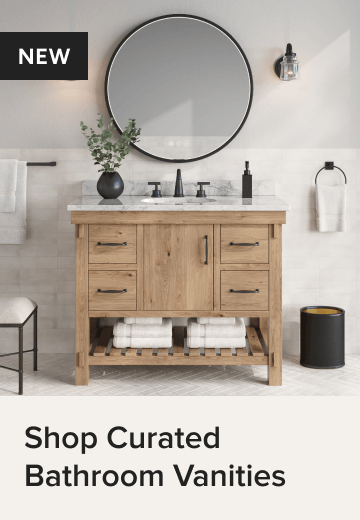
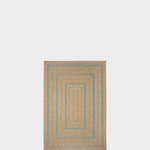
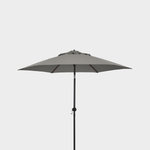
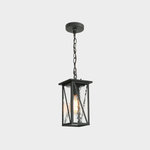
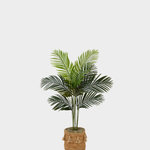










Yard at a Glance
Who lives here: Marina Yoakum with her husband, David, and their three sons: Max, age 16, and
twins Chase and Grant, age 12
Location: El Encanto neighborhood of Tucson, Arizona
Size: 8,712 square feet (809 square meters)
Landscape designer: Prideaux Design
Landscape contractor: Desert State Landscape Construction
An avid fan of midcentury modern design as well as a collector, Marina Yoakum first felt drawn to the tired Tucson property when she spotted its breeze blocks in an estate sale listing. Once she discovered that the property had many additional charms, she snapped it up and hired local interior and landscape designer Kathryn Prideaux to help rejuvenate it inside and out. We’ll be focusing on the outdoor areas here.
See the interior renovation in this companion Houzz Tour